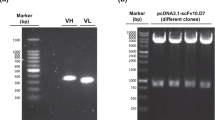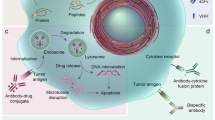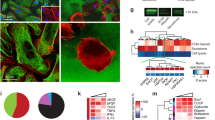Abstract
Targeting tumor vasculature represents an interesting approach for the treatment of solid tumors. The αvβ3 integrins have been found to be specifically associated with angiogenesis in tumors. By using bacteriophage display technology, Ruoslahti et al found that a group of peptides containing the RGD (Arg-Gly-Asp) motif have high-binding affinity to the αvβ3 integrins in tumors. In this study, we designed a fusion protein containing the RGD sequence and the Fc fragment of mouse IgG in order to target the Fc portion of IgG to the tumor vasculature to elicit an antiangiogenesis immune response. In vivo angiogenesis and tumor studies demonstrated that the fusion protein (RGD/mFc) inhibited tumor angiogenesis and tumor growth and improved overall survival. This approach may generate new therapeutic agents for solid tumor treatment.
This is a preview of subscription content, access via your institution
Access options
Subscribe to this journal
Receive 12 print issues and online access
$259.00 per year
only $21.58 per issue
Buy this article
- Purchase on Springer Link
- Instant access to full article PDF
Prices may be subject to local taxes which are calculated during checkout








Similar content being viewed by others
References
Risau W . Mechanisms of angiogenesis. Nature. 1997;386:671–674.
Zetter BR . Angiogenesis and tumor metastasis. Annu Rev Med. 1998;49:407–424.
Bicknell R . Tumor Angiogenesis. Oxford: Oxford University Press; 1997: 19–28.
Folkman J . Cancer: Principles and Practice of Oncology. New York: Lippincott-Raven; 1997: 3075–3087.
O'Reilly MS, Boehm T, Shing Y, et al. Ebdostatin: an endogenous inhibitor of angiogenesis and tumor growth. Cell. 1997;88:277–285.
Bergers G, Javaherian K, Lo KM, Folkman J, Hanahan D . Effects of angiogenesis inhibitors on multistage carcinogenesis in mice. Science. 1999;284:808–812.
Brooks PC, Clark RA, Cheresh DA . Requirement of vascular integrin αvβ3 for angiogenesis. Science. 1994;264:569–571.
Tarli L, Balza E, Viti F, et al. A high-affinity human antibody that targets tumoral blood vessels. Blood. 1999;94:192–198.
Marty C, Scheidegger P, Ballmer-Hofer K, Klemenz R, Schwendener RA . Production of functionalized single-chain Fv antibody fragments binding to the ED-B domain of the B-isoform of fibronectin in Pichia pastoris. Protein Exp Purifi. 2001;21:156–164.
Carnemolla B, Borsi L, Balza E, et al. Enhancement of the antitumor properties of interleukin-2 by its targeted delivery to the tumor blood vessel extracellular matrix. Blood. 2002;99:1659–1665.
Pasqualini R, Koivunen E, Ruoslahti E . αv integrins as receptors for tumor targeting by circulating ligands. Nat Biotechol. 1997;15:542–546.
Assa-Munt N, Jia X, Laakkonen P, Ruoslahti E . Solution structures and integrin binding activities of an RGD peptide with two isomers. Biochemistry. 2001;40:2373–2378.
Ellerby HM, Arap W, Ellerby LM, et al. Anti-cancer activity of targeted pro-apoptotic peptides. Nat Med. 1999;5:1032–1038.
Abbas AK, Lichtman AH, Pober JS . Cellular and Molecular Immunology. Philadelphia, PA: WB. Saunders Company; 2000: 60–61.
Hu Z, Garen A . Intratumoral injection of adenoviral vectors encoding tumor-targeted immunoconjugates for cancer immunotherapy. Proc Natl Acad Sci USA. 2000;97:9221–9225.
Hu Z, Garen A . Targeting tissue factor on tumor vascular endothelial cells and tumor cells for immunotherapy in mouse models of prostatic cancer. Proc Natl Acad Sci USA. 2001;98:12180–12185.
Acknowledgements
We thank Eric Holle for his work in animal care and maintenance, and Lakendra Workman for her expert secretarial assistance. This work was supported in part by the Oncology Research Foundation of the Greenville Hospital System, Greenville, SC, USA
Author information
Authors and Affiliations
Corresponding author
Rights and permissions
About this article
Cite this article
Li, J., Ji, J., Holmes, L. et al. Fusion protein from RGD peptide and Fc fragment of mouse immunoglobulin G inhibits angiogenesis in tumor. Cancer Gene Ther 11, 363–370 (2004). https://doi.org/10.1038/sj.cgt.7700707
Received:
Published:
Issue Date:
DOI: https://doi.org/10.1038/sj.cgt.7700707
Keywords
This article is cited by
-
Current progress in innovative engineered antibodies
Protein & Cell (2018)
-
Experimental Study on Transarterial Administration of GRGDSP Combined with Transarterial Chemoembolization in Rats with Hepatic Carcinoma
CardioVascular and Interventional Radiology (2008)
-
Nanocarriers as an emerging platform for cancer therapy
Nature Nanotechnology (2007)



